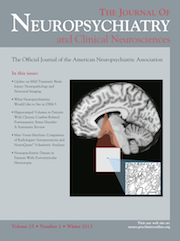Can the Chaotic Nature of Parkinson’s Disease Be Used to Evaluate the Effect of Medication on Parkinson's Disease Symptoms?
To the Editor: Parkinson's disease (PD) is the second most common neurodegenerative disorder after Alzheimer’s disease. Patients with PD develop motor symptoms such as muscular rigidity, slowness of movement, and reduced gait speed, as well as non-motor deficits such as disorders of mood and distinctive alteration of speech and voice (hypokinetic dysarthria).1 The severity of PD can be detected by these symptoms.
Experimental and theoretical evidence shows that complex biological systems, especially the nervous system, have non-linear and chaotic properties.2 Investigations of chaotic activities in physiologic systems suggest that changes in non-linear dynamic measures may indicate states of pathophysiological dysfunction.3,4 Walking is regulated through a complex motor-control system that produces a complex stride interval time series that is characterized by fractal and multi-fractal properties. On the other hand, studies on PD show that, although the chaotic nature of stride interval time is maintained, its chaotic properties change and more or less approach a stochastic state.5 Observations in computer models of the vocal folds and non-linear dynamic analysis of human voices have established the existence of chaos in human voice production. As noted by many researchers, the non-linearities of the voice source mechanisms (i.e., the non-linear pressure flow relation in the glottis, the non-linear stress/strain curves of vocal fold tissues, and the non-linearities associated with vocal fold collision) make this development unsurprising.3 This evidence suggests that chaos theory and non-linear dynamic methods might potentially be applied to diagnose and classify the motor symptoms as well as non-motor deficits in PD and evaluate the effect of medication.
Therefore, motor-symptom data (e.g., ambulatory activity data) or non-motor symptoms data (e.g., voice data) can be used to evaluate the effect of medication on the PD symptoms, based on the chaotic nature of PD. As mentioned, pathological dysfunction, especially PD, alters the chaotic property of biological systems. In chaotic states, each time we record the data, different quantities are achieved. It is worth noting that, at any minute, error or noise in experimental conditions leads to a great change in chaotic system results, because chaotic systems are very sensitive to initial and environmental conditions. Hence, some global features of data related to deterministic chaos are needed to evaluate biological behavior.6 Methods based on non-linear dynamics, including general dimension (Hausdorff dimension, information dimension, correlation dimension, etc.), entropy (Kolmogrov entropy, second-order entropy, etc.), and Lyapunov exponents, enable us to quantitatively describe chaotic behavior.3,4 Non-linear features extracted from signals coming from PD patients can be classified by proper classifiers—such as the ones we used in our previous works7—to evaluate the effect of medication on the PD symptoms. Clinical observations are needed to gather labeled data for PD symptoms, especially PD non-motor symptoms (e.g., voice data) during treatment.
1 : Quantitative acoustic measurements for characterization of speech and voice disorders in early, untreated Parkinson’s disease. J Acoust Soc Am 2011; 129:350–367Crossref, Medline, Google Scholar
2 : Design of a chaotic neural network for training and retrieval of grayscale and binary patterns. Neurocomputing 2011; 74(17):2824–2833Crossref, Google Scholar
3 : Chaos in voice, from modeling to measurement. Journal of Voice, 03/01/2006Google Scholar
4 : Nonlinear Signal Processing for Voice Disorder Detection by Using Modified GP Algorithm and Surrogate Data Analysis. The 7th IEEE International Symposium on Signal Processing and Information Technology 2007, Cairo, EgyptGoogle Scholar
5 : Fractal dynamics in physiology: alterations with disease and aging. Proc Natl Acad Sci U S A 2002; 99(Suppl 1):2466–2472Crossref, Medline, Google Scholar
6 : Is the chaotic nature of Parkinson’s disease prone to simulation?” J Neuropsychiatry Clin Neurosci 2009; 21:101–102Google Scholar
7 : Design of chaotic neural network for robust phoneme recognition. The 8th IEEE International Symposium on Signal Processing and Information Technology, ISSPIT 2008, Sarajevo, Bosnia and HerzegovinaGoogle Scholar



